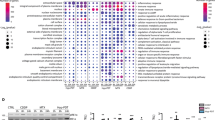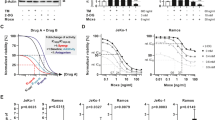Abstract
In contrast to other cytotoxic agents including anthracyclins and oxaliplatin (OXP), cisplatin (CDDP) fails to induce immunogenic tumor cell death that would allow to stimulate an anticancer immune response and hence to amplify its therapeutic efficacy. This failure to induce immunogenic cell death can be attributed to CDDP's incapacity to elicit the translocation of calreticulin (CRT) from the lumen of the endoplasmic reticulum (ER) to the cell surface. Here, we show that, in contrast to OXP, CDDP is unable to activate the protein kinase-like ER kinase (PERK)-dependent phosphorylation of the eukaryotic translation initiation factor 2α (eIF2α). Accordingly, CDDP also failed to stimulate the formation of stress granules and macroautophagy, two processes that only occur after eIF2α phosphorylation. Using a screening method that monitors the voyage of CRT from the ER lumen to the cell surface, we identified thapsigargin (THAPS), an inhibitor of the sarco/ER Ca2+-ATPase as a molecule that on its own does not stimulate CRT exposure, yet endows CDDP with the capacity to do so. The combination of ER stress inducers (such as THAPS or tunicamycin) and CDDP effectively induced the translocation of CRT to the plasma membrane, as well as immunogenic cell death, although ER stress or CDDP alone was insufficient to induce CRT exposure and immunogenic cell death. Altogether, our results underscore the contribution of the ER stress response to the immunogenicity of cell death.
This is a preview of subscription content, access via your institution
Access options
Subscribe to this journal
Receive 50 print issues and online access
$259.00 per year
only $5.18 per issue
Buy this article
- Purchase on Springer Link
- Instant access to full article PDF
Prices may be subject to local taxes which are calculated during checkout







Similar content being viewed by others
References
Apetoh L, Ghiringhelli F, Tesniere A, Criollo A, Ortiz C, Lidereau R et al. (2007). The interaction between HMGB1 and TLR4 dictates the outcome of anticancer chemotherapy and radiotherapy. Immunol Rev 220: 47–59.
Booth C, Koch GL . (1989). Perturbation of cellular calcium induces secretion of luminal ER proteins. Cell 59: 729–737.
Casares N, Pequignot MO, Tesniere A, Ghiringhelli F, Roux S, Chaput N et al. (2005). Caspase-dependent immunogenicity of doxorubicin-induced tumor cell death. J Exp Med 202: 1691–1701.
Delmastro DA, Li J, Vaisman A, Solle M, Chaney SG . (1997). DNA damage inducible-gene expression following platinum treatment in human ovarian carcinoma cell lines. Cancer Chemother Pharmacol 39: 245–253.
Garg AD, Nowis D, Golab J, Vandenabeele P, Krysko DV, Agostinis P . (2009). Immunogenic cell death, DAMPs and anticancer therapeutics: an emerging amalgamation. Biochim Biophys Acta 1805: 53–71.
Ghiringhelli F, Apetoh L, Tesniere A, Aymeric L, Ma Y, Ortiz C et al. (2009). Activation of the NLRP3 inflammasome in dendritic cells induces IL-1beta-dependent adaptive immunity against tumors. Nat Med 15: 1170–1178.
Gourdier I, Crabbe L, Andreau K, Pau B, Kroemer G . (2004). Oxaliplatin-induced mitochondrial apoptotic response of colon carcinoma cells does not require nuclear DNA. Oncogene 23: 7449–7457.
Green DR, Ferguson T, Zitvogel L, Kroemer G . (2009). Immunogenic and tolerogenic cell death. Nat Rev Immunol 9: 353–363.
Harding HP, Zhang Y, Ron D . (1999). Protein translation and folding are coupled by an endoplasmic-reticulum-resident kinase. Nature 397: 271–274.
Kabeya Y, Mizushima N, Ueno T, Yamamoto A, Kirisako T, Noda T et al. (2000). LC3, a mammalian homologue of yeast Apg8p, is localized in autophagosome membranes after processing. EMBO J 19: 5720–5728.
Kaufman RJ . (1999). Stress signaling from the lumen of the endoplasmic reticulum: coordination of gene transcriptional and translational controls. Genes Dev 13: 1211–1233.
Kedersha NL, Gupta M, Li W, Miller I, Anderson P . (1999). RNA-binding proteins TIA-1 and TIAR link the phosphorylation of eIF-2 alpha to the assembly of mammalian stress granules. J Cell Biol 147: 1431–1442.
Kepp O, Gdoura A, Martins I, Panaretakis T, Schlemmer F, Tesniere A et al. (2010). Lysyl tRNA synthetase is required for the translocation of calreticulin to the cell surface in immunogenic death. Cell Cycle 9: 3072–3077.
Krause KH, Michalak M . (1997). Calreticulin. Cell 88: 439–443.
Kroemer G, Galluzzi L, Vandenabeele P, Abrams J, Alnemri ES, Baehrecke EH et al. (2009). Classification of cell death: recommendations of the Nomenclature Committee on Cell Death 2009. Cell Death Differ 16: 3–11.
Kroemer G, Martin SJ . (2005). Caspase-independent cell death. Nat Med 11: 725–730.
Lytton J, Westlin M, Hanley MR . (1991). Thapsigargin inhibits the sarcoplasmic or endoplasmic reticulum Ca-ATPase family of calcium pumps. J Biol Chem 266: 17067–17071.
Martins I, Tesniere A, Kepp O, Michaud M, Schlemmer F, Senovilla L et al. (2009). Chemotherapy induces ATP release from tumor cells. Cell Cycle 8: 3723–3728.
Metivier D, Dallaporta B, Zamzami N, Larochette N, Susin SA, Marzo I et al. (1998). Cytofluorometric detection of mitochondrial alterations in early CD95/Fas/APO-1-triggered apoptosis of Jurkat T lymphoma cells. Comparison of seven mitochondrion-specific fluorochromes. Immunol Lett 61: 157–163.
Obeid M, Panaretakis T, Joza N, Tufi R, Tesniere A, van Endert P et al. (2007a). Calreticulin exposure is required for the immunogenicity of gamma-irradiation and UVC light-induced apoptosis. Cell Death Differ 14: 1848–1850.
Obeid M, Tesniere A, Ghiringhelli F, Fimia GM, Apetoh L, Perfettini JL et al. (2007b). Calreticulin exposure dictates the immunogenicity of cancer cell death. Nat Med 13: 54–61.
Orvedahl A, Levine B . (2009). Autophagy in mammalian antiviral immunity. Curr Top Microbiol Immunol 335: 267–285.
Panaretakis T, Joza N, Modjtahedi N, Tesniere A, Vitale I, Durchschlag M et al. (2008). The co-translocation of ERp57 and calreticulin determines the immunogenicity of cell death. Cell Death Differ 15: 1499–1509.
Panaretakis T, Kepp O, Brockmeier U, Tesniere A, Bjorklund AC, Chapman DC et al. (2009). Mechanisms of pre-apoptotic calreticulin exposure in immunogenic cell death. EMBO J 28: 578–590.
Patterson SD, Spahr CS, Daugas E, Susin SA, Irinopoulou T, Koehler C et al. (2000). Mass spectrometric identification of proteins released from mitochondria undergoing permeability transition. Cell Death Differ 7: 137–144.
Rello-Varona S, Kepp O, Vitale I, Michaud M, Senovilla L, Jemaa M et al. (2010). An automated fluorescence videomicroscopy assay for the detection of mitotic catastrophe. Cell Death Disease 1: e25; doi:10.1038/cddis.2010.6.
Snapp EL, Sharma A, Lippincott-Schwartz J, Hegde RS . (2006). Monitoring chaperone engagement of substrates in the endoplasmic reticulum of live cells. Proc Natl Acad Sci USA 103: 6536–6541.
Spisek R, Charalambous A, Mazumder A, Vesole DH, Jagannath S, Dhodapkar MV . (2007). Bortezomib enhances dendritic cell (DC)-mediated induction of immunity to human myeloma via exposure of cell surface heat shock protein 90 on dying tumor cells: therapeutic implications. Blood 109: 4839–4845.
Tajeddine N, Galluzzi L, Kepp O, Hangen E, Morselli E, Senovilla L et al. (2008). Hierarchical involvement of Bak, VDAC1 and Bax in cisplatin-induced cell death. Oncogene 27: 4221–4232.
Tesniere A, Schlemmer F, Boige V, Kepp O, Martins I, Ghiringhelli F et al. (2010). Immunogenic death of colon cancer cells treated with oxaliplatin. Oncogene 29: 482–491.
Tourriere H, Chebli K, Zekri L, Courselaud B, Blanchard JM, Bertrand E et al. (2003). The RasGAP-associated endoribonuclease G3BP assembles stress granules. J Cell Biol 160: 823–831.
Tufi R, Panaretakis T, Bianchi K, Criollo A, Fazi B, Di Sano F et al. (2008). Reduction of endoplasmic reticulum Ca2+ levels favors plasma membrane surface exposure of calreticulin. Cell Death Differ 15: 274–282.
Vandenabeele P, Declercq W, Vanden Berghe T . (2008). Necrotic cell death and ‘necrostatins’: now we can control cellular explosion. Trends Biochem Sci 33: 352–355.
von Haefen C, Gillissen B, Hemmati PG, Wendt J, Guner D, Mrozek A et al. (2004). Multidomain Bcl-2 homolog Bax but not Bak mediates synergistic induction of apoptosis by TRAIL and 5-FU through the mitochondrial apoptosis pathway. Oncogene 23: 8320–8332.
Yang Z, Schumaker LM, Egorin MJ, Zuhowski EG, Guo Z, Cullen KJ . (2006). Cisplatin preferentially binds mitochondrial DNA and voltage-dependent anion channel protein in the mitochondrial membrane of head and neck squamous cell carcinoma: possible role in apoptosis. Clin Cancer Res 12: 5817–5825.
Zitvogel L, Kepp O, Kroemer G . (2010). Decoding cell death signals in inflammation and immunity. Cell 140: 798–804.
Acknowledgements
GK is supported by the Ligue Nationale contre le Cancer (Equipes labellisée), Agence Nationale pour la Recherche (ANR), European Commission (Apo-Sys, ChemoRes, ApopTrain), Fondation pour la Recherche Médicale (FRM), Institut National du Cancer (INCa) and Cancéropôle Ile-de-France. IM is supported by the Ligue Nationale contre le Cancer, OK is supported by AICR and FS by FRM.
Author information
Authors and Affiliations
Corresponding author
Ethics declarations
Competing interests
The authors declare no conflict of interest.
Additional information
Supplementary Information accompanies the paper on the Oncogene website
Rights and permissions
About this article
Cite this article
Martins, I., Kepp, O., Schlemmer, F. et al. Restoration of the immunogenicity of cisplatin-induced cancer cell death by endoplasmic reticulum stress. Oncogene 30, 1147–1158 (2011). https://doi.org/10.1038/onc.2010.500
Received:
Revised:
Accepted:
Published:
Issue Date:
DOI: https://doi.org/10.1038/onc.2010.500
Keywords
This article is cited by
-
Effects of Leea indica leaf extracts and its phytoconstituents on natural killer cell-mediated cytotoxicity in human ovarian cancer
BMC Complementary Medicine and Therapies (2023)
-
Potentiation of combined p19Arf and interferon-beta cancer gene therapy through its association with doxorubicin chemotherapy
Scientific Reports (2022)
-
Immunogenic cell stress and death
Nature Immunology (2022)
-
Stress-induced inflammation evoked by immunogenic cell death is blunted by the IRE1α kinase inhibitor KIRA6 through HSP60 targeting
Cell Death & Differentiation (2022)
-
Ischemia and reperfusion injury combined with cisplatin induces immunogenic cell death in lung cancer cells
Cell Death & Disease (2022)



